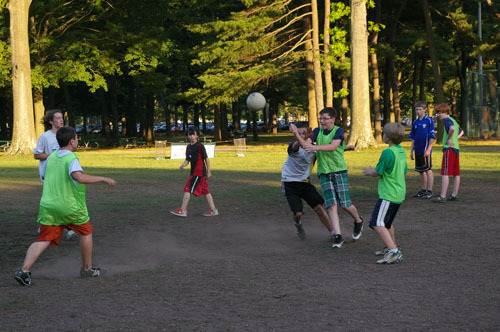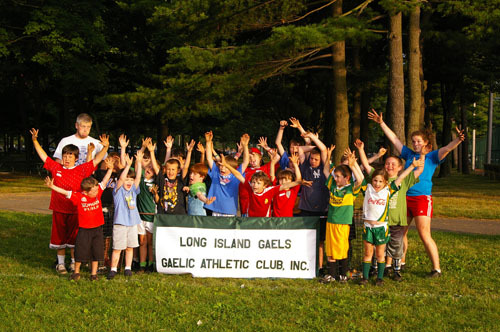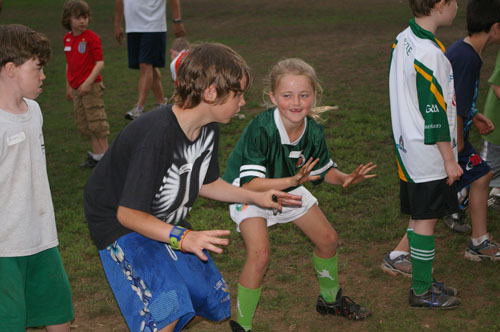Gaelic football fever hits Long Island
Local kids take on popular Irish sport at Eisenhower Park
It's football time in Nassau.
Not the American version set to kick off next month. Nor the game with global reach that took center stage at this year's FIFA World Cup.
Instead, it is Gaelic football that owns the spotlight this month in Eisenhower Park. The East Meadow park will host the Gaelic Athletic Association Continental Youth Championships, beginning on Thursday, July 29. The GAA tournament includes teams from as close to home as Long Island and the Bronx and as far away as England and Canada.
The Long Island Gaels Minor Board, which has teams in all youth divisions, held a week of training in June to prepare current players and newcomers for the competition.
"The CYC is going to be intense," said Rosemarie Byrne, a Huntington resident and an officer for the L.I. Gaels Minor Board.
The tournament begins with a parade through Rockville Centre on July 29 at 7 p.m. Games kick off on July 30 and run until Aug. 1 at various fields in Eisenhower Park. Organizers said more than a thousand local hotel rooms have already been booked for the tournament.
Seamus Kerr, president of the L.I. Gaels, compares Gaelic football to a combination of basketball and soccer.
Gaelic football is played on a pitch, about the size of a soccer field. There are 15 players on each side — six forwards, six backs, two midfielders and a goalkeeper. A game consists of two 30-minute halves.
Using a ball similarly shaped liked the one used in soccer, but heavier, players can carry it for four steps. To advance further, they must either pass to a teammate, kick, shoot, or dribble. Players in the youth league can dribble by bouncing or kicking the ball up to themselves. Hand passes are punched, not thrown. Throwing is against the rules and can result in a technical foul.
To score, players have the option of kicking or punching the ball over the goalposts for one point, or kick it past the goalkeeper in the net for three points.
Gaelic football is considered by many to be Ireland's most popular sport, along with hurling and soccer.
Connor Byrne, son of Rosemarie and Mike Byrne, explained why he concentrates his athletic abilities on Gaelic football rather than more mainstream youth sports like soccer. "There is a lot more scoring than in soccer," he said. "It's very fast paced and exciting. This is fairly unique because you can use your hands and your feet — in most sports you can use either your hands or feet."
Shannon Hughes, who competed on New York's state all-star youth team last year, emphasized the amount of skills required to play the game the right way.
"You need a lot of skill," said Hughes, who lives in Long Beach. "It takes a lot of practice."
Though players do not wear equipment other than uniform shorts and tops, with cleats, there is a degree of physical contact that rises with the age level. Shoulder-to-shoulder contact is allowed, as well as players slapping the ball away from opponents.
The Long Island Gaels Gaelic football club was formed in 2001. Three years later, the adult league created a minor board for youth competition. There are currently about 60 players spanning four teams on the youth level.
In areas where Gaelic football is really popular — in the Bronx and in Rockland County — hundreds of kids compete.
To boost interest and train players for the upcoming tournament, the Gaels hosted a free four-day clinic at Eisenhower Park in June.
Also, as Kerr points out, opportunities open up for successful youth Gaelic football players. His daughter, Nicole Kerr, and her teammate, Hughes, competed for the New York State all-star squad. With the team, they got a free trip in Ireland to compete against other squads from around the world.
Unlike other local sports, Gaelic football is free for youth competitors. That is made possible with the support of the Irish American Society, the Ancient Order of Hibernians and the Rockville Centre Parade Committee.
For Rosemarie Byrne, whose four children all played Gaelic football, the game also serves as an important tool in introducing kids to other origins of Irish culture — like the Gaelic language, dancing and music.
"If you keep the kids in something Irish like this," she said, "you expose them to all the other aspects of the culture."















